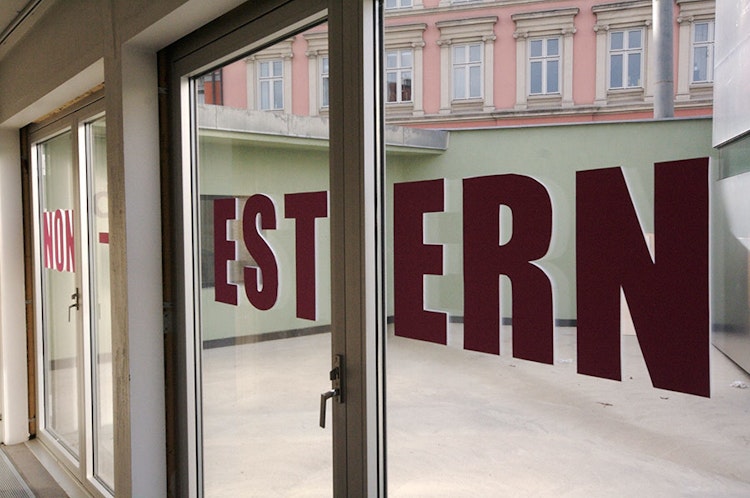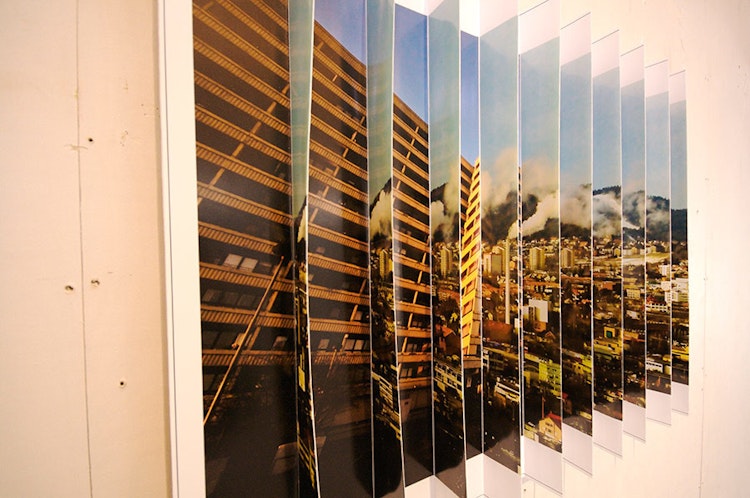
Babylon Heights (2008), Christian Bermudez. Photo: ROM

Babylon Heights (2008), Christian Bermudez. Photo: ROM
Hi, what are you looking for?
Christian Bermudez
February 28th. 2008
Everyone knows the story: after the great flood, men emigrated from east, settled and started building the greatest tower. While on their way to heaven, languages got confused and having failed in their attempt, humankind scattered throughout the earth.
For mankind, having well-intended and common goals will not be enough, when incapable of agreeing on the words to be used first. The pursuit of the highest level; as in the case of modernism or the garden city, is doomed to become a failed utopia by the tower’s legacy. This is the point of departure for Babylon Heights.

Babylon Heights (2008), Christian Bermudez. Photo: ROM

Babylon Heights (2008), Christian Bermudez. Photo: ROM

Babylon Heights (2008), Christian Bermudez. Photo: ROM
The exhibition opens with the statement ‘sick and tired of being sick and tired’ which is the title of a work where "piece of action" has been drilled on a surface. Standing beyond the holes and the main structure another text appears: "non western".
In a year committed to ‘diversity’ (Mangfoldsåret) Bermudez finds it jeopardizing to bring out his origins. He aspires to create an art piece were ethnicity plays no role. Nevertheless, when one stands westards in the gallery, letting the eye fill the void between the piece's surface and its background, issues of identity, cultural policies and otherness appear on the horizon.
Bermudez’ ‘non-western nature’ of not being born in either Europe, USA, or in Australia, is problematized through the absence of material on a wall that resembles the pristine white cube, as much as other western institutions yearning for their long gone, when not glorified, homogeneity.
Everyone knows the story: There can be no east without west and no west without east. Pictures of east tell more about the fears and lacks of West rather than showing an alterity. When not only presenting a simplistic opposition: Lyn vs Vålerenga, CNN vs Al-Jazera, Frogner vs Tveita.
Once the cardinal directions has been set, holding a compass in hand the exhibition moves 6 km east of Oslo’s center, towards Tveita Borettslag one of the biggest structures located in the Alna valley with its 819 flats divided in three 13-storey tower blocks. The buildings crown the hills between Groruddalen and Østmarka and their mammoth dimensions became an icon of Norwegian suburbia, as much as a visual flag of East Oslo.
Everyone knows the story: In the beginning it was ‘Béton Brut’ by way of Le Corbusier. He meant: raw concrete, but the concept was turned into 'brutalism' by their detractors.
Tveita Borettslag is one of the clear examples of this architectural movement in Norway . Built towards the end of the 60s, the building has been modified over the years. Plain concrete was not of the taste of the tenants. Then the building was painted in a yellowish-white tone. The original verandas, having a piece of horizontal wood, were painted ‘hytte’ brown and later substituted, by those who could afford it by iron ornaments, whose design is a reminiscent of Norse motives.
The piece ‘Béton Brut à la norvégienne ’ shows that the Norwegianization of the building was clearly intended already in the original structure, as the concrete facade was designed to mimic the panel structure one can find everywhere in Scandinavia.
Then the exhibition travels back to the question of who's talking and specially where from. From the heights at Tveita one could gaze at the best views of the Oslo-fiord, while turning the head northwards, Groruddalen shows all the signs of its industrial stigma. Towards east, Østmarka’s idyllic border appears setting a frontier.
Back at the gallery, a photographic tryptic shows the classical image of Tveita, from the distance. Moving right or left appear other perspectives, this time from Tveita’s balconies. The fact is that one gets one of Oslo ’s best views from one of the city’s most overlooked buildings.
Everyone knows the story: Babylon was condemned, but its tower became a praise to the unfinished, a monument to the impossibility of the total achievement. There are 819 apartments in Tveita Borettslag created under the premises of social democracy where all of them have access to a balcony. All of them regulated under a common set of rules where colors can’t be changed, clothes can’t be hung, birds can’t be fed. Although from the distance all the balconies might look identicall not two of them are alike.

Babylon Heights (2008), Christian Bermudez. Photo: ROM

Babylon Heights (2008), Christian Bermudez. Photo: ROM

Babylon Heights (2008), Christian Bermudez. Photo: ROM

Babylon Heights (2008), Christian Bermudez. Photo: ROM

Babylon Heights (2008), Christian Bermudez. Photo: ROM